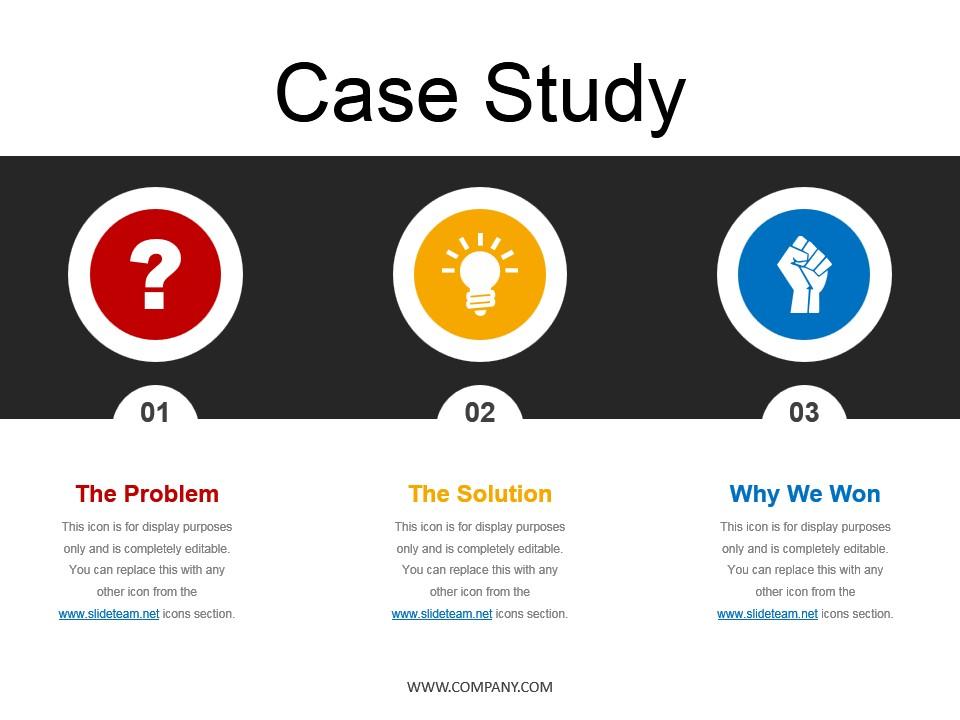Must-Have Financial Case Study Examples with Samples and Templates


2 Comments
Customer Reviews (1)
Case studies are valuable tools for understanding the real-world applications of financial concepts and strategies. They provide insights into practical scenarios, showcasing the decision-making processes and outcomes in various financial situations. Whether you are a student, professional, entrepreneur, having access to well-crafted financial case study templates can be immensely beneficial in developing a deeper understanding of financial principles and honing your analytical skills.
SlideTeam’s premium PPT templates help you grasp complex financial concepts like investment analysis, financial planning, risk management, etc. Each case study offers a unique scenario, presenting a problem or challenge that requires thoughtful analysis and strategic decision-making.
By using these content-ready slides, you can enhance your problem-solving abilities, learn from real-world success stories and mistakes, and gain valuable insights into the intricacies of financial decision-making. The included samples and templates are practical tools for structuring your case studies, enabling you to apply your knowledge and skills to different financial scenarios.
Whether preparing for exams, a professional seeking to broaden your financial expertise, or an entrepreneur looking to make informed business decisions, these financial case study examples, samples, and templates are indispensable resources to elevate your financial understanding and make well-informed decisions in your personal or professional life.
Financial Case Study Templates
Template 1: Financial Case Study Environment Business Solution Problems
Introducing our ready to use template designed to elevate your content and make you look like a presentation pro. With a wide range of PPT slides covering various topics, this deck encompasses all the core areas of your business needs.
The deck focuses on Financial Case Study Environment Business Solution Problems, offering professionally designed templates that combine suitable graphics and relevant content. With eight slides, thoughtfully crafted to enhance your message and captivate your audience.
Don't miss out on this opportunity to impress your audience with visually stunning slides and compelling content. Click the download button and access our pre-designed PPT presentation and take your presentations to the next level. We also have templates to propose a business case if you aim for a higher company turnover.

Template 2: Case Study for Financial Management PowerPoint Template
Introducing our captivating case study template designed to provide an environment conducive to productive discussions and effective decision-making. This template is perfect for showcasing real-life examples and analyzing financial management scenarios visually engagingly.
With its three-stage process, this template simplifies complex concepts and guides your audience through the essential components of a comprehensive business case study. It enables you to present your findings, solutions, and recommendations.
Whether you are analyzing past financial performances, identifying challenges , or proposing solutions, this template provides a flexible framework for organizing and presenting your ideas. You can also elevate your financial management presentations with our marketing Case Study for Financial Management PowerPoint Template . Download it now and unlock a wealth of possibilities to engage your audience, foster integration, and showcase your expertise in financial management.

Conclusion
Financial case studies are invaluable tools for understanding real-world financial scenarios and developing practical solutions. By examining concrete examples, individuals and organizations can gain insights into financial challenges, apply analytical techniques, and make informed decisions.
This article has highlighted the importance of collecting financial case study examples and accompanying samples and templates as valuable resources for learning and applying financial principles in various contexts. These resources can serve as guides for conducting comprehensive analyses, formulating recommendations, and ultimately achieving financial success.
FAQs on Financial Case Study
What is a case study in finance?
A case study in finance is an in-depth analysis of a specific financial situation, company, investment, or financial strategy. It involves examining real-world scenarios, often based on actual events, to understand and evaluate the financial implications, decision-making processes, and outcomes.
In finance, case studies are commonly used as a teaching and learning tool to assess and explore complex financial issues in academic and professional settings. They provide a practical approach to understanding financial theories, concepts, and practices by applying them to real-life situations.
A finance case study typically involves the following elements:
- Background: The case study begins by presenting relevant information about the company, industry, or financial situation under examination. This includes details about the organization's financial statements, market conditions, competitive landscape, and other pertinent background information.
- Problem or Challenge: The case study outlines the specific financial problem or challenge that needs to be addressed. This could be related to financial analysis, investment decisions, capital budgeting, risk management, financial restructuring, or any other financial aspect of the organization.
- Data Analysis: The case study analyzes financial data, such as income statements, balance sheets, cash flow statements, and key financial ratios. Various financial analysis tools and techniques, such as ratio analysis, discounted cash flow analysis, or valuation models, may be used to evaluate the situation.
- Alternatives and Solutions: Based on the analysis, different alternatives or solutions are identified to address the financial problem or challenge. These could include recommendations for financial strategies, investment decisions, capital allocation, cost reduction measures, or other relevant actions.
- Decision-Making and Implementation: The case study explores the decision-making process, considering risk, return, financial feasibility, and strategic considerations. It also discusses the potential implementation of the recommended solution and the expected outcomes.
- Lessons Learned: The case study concludes by discussing the lessons learned from the financial situation or decision-making process. This may involve reflections on successful strategies, potential pitfalls, and broader implications for financial management and decision-making in similar contexts.
How do you write a financial case study?
Writing a financial case study involves analyzing a real or hypothetical financial situation or problem and presenting a detailed examination of the facts, analysis, and potential solutions. Here is a step-by-step guide on how to write a financial case study:
- Identify the purpose and scope: Clearly define the purpose of the case study and the specific financial issue you want to address. Determine the scope of the study, including the period, entities involved, and relevant financial data.
- Gather information: Collect all relevant financial data and supporting documents related to the case. This may include financial statements, transaction records, market data, industry reports, and any other information necessary for the analysis.
- Describe the background: Provide an overview of the company or individual involved in the case study. Include relevant details such as the company's history, industry , size, key stakeholders, and any recent events or developments that may have a financial impact.
- State the problem or objective: Clearly define the financial problem or objective that needs to be addressed. Identify the key challenges or issues the company or individual faces and explain why they are essential.
- Conduct financial analysis: Analyze the financial data and apply appropriate financial analysis techniques to evaluate the situation. This may involve calculating financial ratios, conducting trend analysis, performing a discounted cash flow analysis, or any other relevant method to gain insights into the financial performance and position of the entity.
- Present findings: Summarize the results of the financial analysis clearly and concisely. Highlight key findings, trends, and any significant financial situation factors. Use graphs, charts, or tables to present data effectively.
- Discuss alternative solutions: Propose different options or strategies to address the financial problem or achieve the objective. Determine the advantages and drawbacks of each solution and provide supporting evidence or calculations to justify your recommendations.
- Make recommendations: Make clear and actionable recommendations based on analyzing and evaluating the alternative solutions. Support your recommendations with logical reasoning and explain how they can improve the financial situation or achieve the desired outcome.
- Provide a conclusion: Summarize the main points of the case study and restate the recommendations. Highlight any potential risks or challenges associated with implementing the proposed solutions.
- Include references and citations: If you have used external sources or references, provide proper citations to give credit to the authors and avoid duplicity or redundancy.
- Edit and proofread: Review the case study for clarity, coherence, and accuracy. Check for any grammatical or spelling errors. Ensure that the document is well-structured and easy to understand.
What is finance study?
Finance study refers to the field of knowledge and an academic discipline that focuses on managing, creating, and allocating financial resources. It involves studying various aspects of financial systems, instruments, markets, and institutions. Finance encompasses the theory and practice of managing money, investments, and financial decision-making.
The study of finance covers a wide range of topics, including:
- Corporate Finance: This area focuses on financial decisions and strategies within corporations. It includes capital budgeting, investment analysis, financial planning, risk management, and corporate valuation.
- Investments: This field examines allocating money to different financial assets including, stocks, mutual funds, real estate, and other derivatives. It involves analyzing risk and return, portfolio management, asset pricing models, and investment strategies.
- Financial Institutions and Markets: This area explores the functioning of financial institutions (such as banks, insurance companies, and investment firms) and financial markets (such as stock markets, bond markets, and foreign exchange markets). It involves studying the role of these institutions and markets in facilitating the flow of funds, managing risks, and pricing financial assets.
- International Finance: This branch focuses on financial transactions and relationships between countries and across borders. It covers foreign exchange rates, international investment, multinational corporations, and global financial markets.
- Personal Finance: This area focuses on individual or household financial management. It involves budgeting, saving, investing, retirement planning, taxation, and managing personal debt.
Related posts:
- How Financial Management Templates Can Make a Money Master Out of You
- Top 5 Capital Budgeting Templates with Samples and Examples
- The Ultimate Spokes Diagram Templates to Enhance Business Presentation
- Top 5 One-page Quarterly Report Templates with Examples and Samples



![]()

